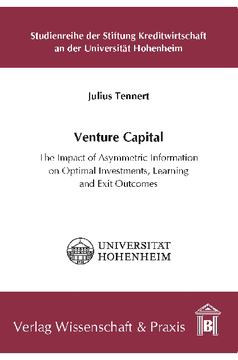Venture Capital

BOOK
Cite BOOK
Style
Format
Venture Capital
The Impact of Asymmetric Information on Optimal Investments, Learning and Exit Outcomes
Studienreihe der Stiftung Kreditwirtschaft an der Universität Hohenheim, Vol. 57
(2019)
Additional Information
Book Details
Pricing
Table of Contents
| Section Title | Page | Action | Price |
|---|---|---|---|
| Preface | 6 | ||
| Contents | 8 | ||
| List of Figures | 10 | ||
| List of Tables | 12 | ||
| List of Abbreviations | 14 | ||
| 1 Introduction | 16 | ||
| 2 Moral Hazard in VC Finance | 22 | ||
| 2.1 Introduction | 22 | ||
| 2.2 Formal Model | 25 | ||
| 2.2.1 The Entrepreneurial Project | 25 | ||
| 2.2.2 Maximization Function of the VC | 27 | ||
| 2.2.3 Participation Constraint of the Entrepreneur | 27 | ||
| 2.2.4 Solution without Relevance of Human Capital | 29 | ||
| 2.2.5 Solution with Relevance of Human Capital | 30 | ||
| 2.2.6 Opportunity Loss of the VC | 30 | ||
| 2.3 Empirical Approach | 35 | ||
| 2.3.1 Sample | 35 | ||
| 2.3.2 Econometric Method | 35 | ||
| 2.3.3 Measures | 37 | ||
| 2.3.4 Empirical Results | 40 | ||
| 2.3.5 Robustness Checks | 44 | ||
| 2.4 Conclusion | 50 | ||
| 3 Learning in Funding Relationships | 54 | ||
| 3.1 Introduction | 54 | ||
| 3.2 Learning and Comprehensiveness | 57 | ||
| 3.3 Frictions in the Learning Process | 59 | ||
| 3.4 Formal Hypotheses | 61 | ||
| 3.5 Data and Methodology | 64 | ||
| 3.5.1 Sample | 64 | ||
| 3.5.2 Measures | 65 | ||
| 3.5.3 Econometric Specification | 75 | ||
| 3.6 Results | 78 | ||
| 3.6.1 Summary Statistics and Selection Regressions | 78 | ||
| 3.7 Conclusion | 87 | ||
| 4 VCs as Intermediaries in Exits | 92 | ||
| 4.1 Introduction | 92 | ||
| 4.2 Agency Cost in IPO and Trade Sale Exits | 95 | ||
| 4.2.1 Adverse Selection Pre-Exit | 95 | ||
| 4.2.2 Moral Hazard Post-Exit | 96 | ||
| 4.3 Investor Characteristics | 98 | ||
| 4.4 Firm Characteristics | 101 | ||
| 4.5 Sample and Methodology | 102 | ||
| 4.5.1 Sample | 102 | ||
| 4.5.2 Methodology | 103 | ||
| 4.5.3 Control Variables | 104 | ||
| 4.6 Results | 106 | ||
| 4.6.1 Descriptive Statistics | 106 | ||
| 4.6.2 Multivariate Analysis | 112 | ||
| 4.6.3 Classification Tree Analysis | 117 | ||
| 4.7 Conclusion | 129 | ||
| 5 Conclusion | 132 | ||
| 5.1 Summary of the Main Results | 132 | ||
| 5.2 Outlook | 133 | ||
| Bibliography | 136 |
